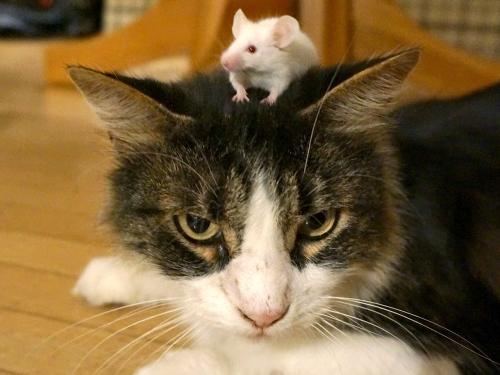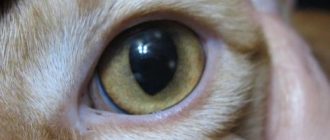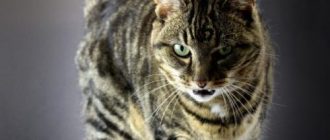What is anorexia?
Contents
Anorexia is a condition characterized by a decrease or complete loss of appetite. Hunger is a physical stimulus, but an appetite – rather a psychological stimulus. There are two types of anorexia: true anorexia and pseudoanorexia. Both types result in reduce food intake, but a cat with pseudoanorexia is hungry (hungry) but cannot, due to difficulty in chewing, swallowing, or any other reasons. No matter what type of anorexia the cat suffers, external signs of this will be a decrease in appetite and food intake that should be taken seriously. These symptoms may indicate potentially life-threatening root causes diseases. Poor appetite and refusal to eat are usually associated with severe illness and general recommendation for all cat owners is an appeal to veterinary care.

What are the causes of anorexia and pseudoanorexia?
There are many potential reasons for reducing consumption. food, and the first, important step in identifying them is to understand a cat suffers from real or pseudoanorexia. Does she want to eat but can’t, or is she really not interested in food? Your the veterinarian needs to know the cat’s history in detail to understand what may be the root cause of the disease. Next, he will conduct a thorough physical examination for obvious physical explanations reduce food intake. Then, if necessary, there will be necessary diagnostic tests have been performed. Tests may include laboratory tests such as blood tests, mineral tests balance, x-ray of the chest and abdomen, ultrasound and possibly endoscopy.
Potential causes of pseudoanorexia when a cat cannot eat or has serious difficulty eating include yourself:
- Stomatitis, gingivitis, esophagitis and pain in the tissues of the oral cavity and throat.
- Periodontal disease that can spread to healthy teeth.
- Abscesses in the orbit.
- Chewing muscle pain.
- Pain in the temporomandibular joint.
- Cytomegaly.
- Diseases of the nervous system that affect chewing and swallowing.
- Cancer or swelling of the mouth, tongue, or tonsils.
- Pain in other parts of the body. Chronic pain can suppress the cat’s appetite and ability to get to food or water, for example, with back pain.
Real anorexia can also have many different reasons:
- Severe illnesses such as infections or dysfunctions certain organs.
- Poisoning.
- Psychological problems such as stress, changes routine of the day and the environment, unpleasant or undesirable food.
- Diseases of the immune system.
- The cat is not able to smell the aroma. The smell is important factor when eating food.
- Cancer of all types.
- Intestinal obstruction.
- An ulcer of the stomach or intestines.
- High ambient temperature.
- Side effects of drugs.
How to treat anorexia?
In the treatment of any type of anorexia, it is crucial determination and elimination of its root cause. In other words, treatment depends entirely on the diagnosis. Adjunctive therapy may be focused on controlling the symptoms of anorexia. For example, if if the cat is dehydrated, it may require intravenous injection liquids. Any nausea should be eliminated. If appropriate, then the veterinarian should prescribe a short-term appetite stimulator, such like cyprogenptadine or mirtazapine. With a lack of minerals such like potassium, potassium supplements may be prescribed. Your vet should help you with specific recommendations, but simple steps, who can help you are:
- Adding canned foods to the diet
- Heating food to approximately cat body temperature (~ 38 ° C).
- Add a small amount of low-content chicken sodium, vegetable or meat broth.
- Homemade recipes according to your veterinarian’s recipes.
Sometimes cats suffering from anorexia associated with a disorder metabolism must receive nutrients to cure but they don’t want to eat them. In these cases, on the recommendation of a veterinarian, you may need to place the feeding tube in the esophagus, stomach or small intestine. Tube feeding is not extreme treatment, but it often helps save a life pet. Food and medicine can thus be delivered. virtually no stress for the cat. If the cat’s digestive system works, then it should be used, even if for this tube feeding will be required for some time.
If the cat’s digestive system does not work for any reason, the veterinarian may recommend the so-called parenteral nutrition, which is administered intravenously. Parenteral nutrition is specialized, complex a method of administering nutrients and drugs, which is performed by a qualified technician in specialized center.
Regardless of the cause of reduced food intake or changes eating habits, the cat usually needs a comprehensive examination. Any loss or loss of appetite may signal a dangerous disease and may ultimately lead to a potentially life-threatening outcome for the pet. Is always note changes in your cat’s diet and, if you notice something unusual, do not hesitate and show it to the veterinarian.






